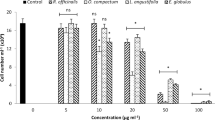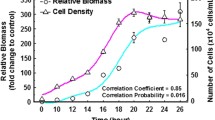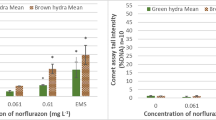Abstract
This study investigated the effects of gamma-radiation on Tetrahymena pyriformis. The experimental approach consists of exposing T. pyriformis growing in presence of Cesium-137 (137Cs) at dose rates of 1, 2, 4, and 6 cGy h−1 and Cobalt-60 (60Co) at dose rates of 8, 10, 15, and 20 cGy h−1. The radiation doses effects on growth, morphology, some metabolic enzymes, and reactive oxygen species (ROS) markers have been evaluated. When cells were growing in irradiating conditions at dose rates beyond 4 cGy h−1, a decreasing of cells and generation numbers with a prolongation of generation time and a change of morphological aspect with rounding-off of cells were observed compared to the control. The 50%-inhibitory dose (ID50) for radiation was estimated at 1568.72 ± 158.45 cGy. The gamma-radiation at dose rates more than 6 cGy h−1, affected both glyceraldehyde 3-phosphate dehydrogenase and succinate dehydrogenase by inhibiting their activities. All of these effects were more pronounced when cells were irradiated at the dose rate of 20 cGy h−1 using 60Co source. For ROS markers generated by gamma-radiation in T. pyriformis, the results showed an increase of the lipid peroxidation in cells grown in presence of gamma-radiation at dose rates more than 6 cGy h−1 and an enhancement in catalase and superoxide dismutase activities from the dose rate of 1 cGy h−1. These encouraging results suggested the use of T. pyriformis as a unicellular model cell to investigate other aspects of the response to ionizing radiation.



Similar content being viewed by others
Data Availability
Not applicable.
Code Availability
Not applicable.
References
Gross L (2007) Paradox resolved? The strange case of the radiation resistant bacteria. PLoS Biol 5(4):e108. https://doi.org/10.1371/journal.pbio.0050108
Ramachandran TV (2011) Background radiation, people and the environment. Int J Radiat Res 9(2):63–76. http://ijrr.com/article-1-738-en.pdf. . Accessed 20 Aug 2020
Nair R, Sunny F, Chopra M, Sharma L, Puranik V, Ghosh A (2014) Estimation of radioactive leakages into the Pacific Ocean due to Fukushima nuclear accident. Environ Earth Sci 71(3):1007–1019. https://doi.org/10.1007/s12665-013-2501-1
Miller MO, Miller DA (2016) The technological enhancement of normally occurring radioactive materials in red mud due to the production of alumina. Int J Spectrosc. https://doi.org/10.1155/2016/4589460
Lind OC, Helen Oughton D, Salbu B (2019) The NMBU FIGARO low dose irradiation facility. Int J Radiat Biol 95(1):76–81. https://doi.org/10.1080/09553002.2018.1516906
Hosseinimehr SJ (2007) Trends in the development of radioprotective agents. Drug Discov Today 12(19–20):794–805. https://doi.org/10.1016/j.drudis.2007.07.017
Chaubey RC, Bhilwade HN, Rajagopalan R (2006) Effect of low doses and low dose-rates of gamma radiation on DNA damage in human peripheral blood leukocytes using comet assay. Int J Low Radiat 2(1–2):71–83. https://doi.org/10.1504/IJLR.2006.007897
Andreassi MG, Foffa I, Manfredi S, Botto N, Cioppa A, Picano E (2009) Genetic polymorphisms in xrcc1, ogg1, ape1 and xrcc3 DNA repair genes, ionizing radiation exposure and chromosomal DNA damage in interventional cardiologists. Mutat Res 666(1–2):57–63. https://doi.org/10.1016/j.mrfmmm.2009.04.003
Esnault MA, Legue F, Chenal C (2010) Ionizing radiation: advances in plant response. Environ Exp Bot 68(3):231–237. https://doi.org/10.1016/j.envexpbot.2010.01.007
Beckman KB, Ames BN (1997) Oxidative decay of DNA. J Biol Chem 272(32):19633–19636. https://doi.org/10.1074/jbc.272.32.19633
Berlett BS, Stadtman ER (1997) Protein oxidation in aging, disease, and oxidative stress. J Biol Chem 272(33):20313–20316. https://doi.org/10.1074/jbc.272.33.20313
Vaughan M (1997) Oxidative modification of macromolecules minireview series. J Biol Chem 272(30):18513. https://doi.org/10.1074/jbc.272.30.18513
Whicker FW (1997) Impacts on plant and animal populations. Health impacts of large releases of radionuclides, CIBA Foundation Symposium. Wiley, New York, pp 74–93
Arena C, De Micco V, Macaeva E, Quintens R (2014) Space radiation effects on plant and mammalian cells. Acta Astronaut 104(1):419–431. https://doi.org/10.1016/j.actaastro.2014.05.005
Narendran N, Luzhna L, Kovalchuk O (2019) Sex difference of radiation response in occupational and accidental exposure. Front Genet 10:260. https://doi.org/10.3389/fgene.2019.00260
Garnier-Laplace J, Della-Vedova C, Andersson P, Copplestone D, Cailes C, Beresford NA, Howard BJ, Howe P, Whitehouse P (2010) A multi-criteria weight of evidence approach to derive ecological benchmarks for radioactive substances. J Radiol Prot 30(2):215–233. https://doi.org/10.1088/0952-4746/30/2/s02
Caplin N, Willey N (2018) Ionizing radiation, higher plants, and radioprotection: from acute high doses to chronic low doses. Front Plant Sci 9:847. https://doi.org/10.3389/fpls.2018.00847
Zeuthen E (1971) Synchronization of the Tetrahymena cell cycle. Adv Cell Biol 2:111–152. https://doi.org/10.1007/978-1-4615-9588-5_3
Cameron IL (1973) Growth characteristics of Tetrahymena. In: Elliott AM (ed) Biology of Tetrahymena. Dowden, Hutchinson & Ross, Stroudsburg, Pennsylvania, pp 199–226
Hill DL (1972) The biochemistry and physiology of Tetrahymena. Academic Press, New York
Wheatley DN, Rasmussen L, Tiedtke A (1994) Tetrahymena: a model for growth, cell cycle and nutritional studies, with biotechnological potential. Bio Essays 16(5):367–372. https://doi.org/10.1002/bies.950160512
Darcy P, Kelly JP, Leonard BE, Henry JA (2002) The effect of lofepramine and other related agents on the motility of Tetrahymena pyriformis. Toxicol Lett 128(1–3):207–214. https://doi.org/10.1016/s0378-4274(01)00542-2
Dias N, Mortara RA, Lima N (2003) Morphological and physiological changes in Tetrahymena pyriformis for the in vitro cytotoxicity assessment of triton X-100. Toxicol In Vitro 17(3):357–366. https://doi.org/10.1016/s0887-2333(03)00023-7
Fourrat L, Iddar A, Valverde F, Serrano A, Soukri A (2007) Effects of oxidative and nitrosative stress on Tetrahymena pyriformis glyceraldehyde-3-phosphate dehydrogenase. J Eukaryot Microbiol 54(4):338–346. https://doi.org/10.1111/j.1550-7408.2007.00275.x
Mountassif D, Kabine M, Manar R, Bourhim N, Zaroual Z, Latruffe N, El Kebbaj MS (2007) Physiological, morphological and metabolic changes in Tetrahymena pyriformis for the in vivo cytotoxicity assessment of metallic pollution: Impact on D-β-hydroxybutyrate dehydrogenase. Ecol Indic 7(4):882–894. https://doi.org/10.1016/j.ecolind.2006.11.010
Luckey TD (1986) Ionizing radiation promotes protozoan reproduction. Radiat Res 108(2):215–221. https://doi.org/10.2307/3576827
Elliott AM, Brownell LE, Gross J (1954) The use of Tetrahymena to evaluate the effects of gamma radiation on essential nutrilites. J Protozool 1(4):193–199. https://doi.org/10.1111/j.1550-7408.1954.tb00816.x
Kuncio GS, Rustad RC, Oleinick NL (1972) Fluctuations in the polysome content of gamma-irradiated Tetrahymena pyriformis. Biochem Biophys Res Commun 48(2):457–463. https://doi.org/10.1016/s0006-291x(72)80073-1
Srinivas H, Vakil UK, Sreenivasan A (1975) Evaluation of protein quality of irradiated foods using Tetrahymena pyriformis W. and rat assay. J Food Sci 40:65–69. https://doi.org/10.1111/j.1365-2621.1975.tb03737.x
Wichterman R (1957) Biological effects of radiations on protozoa. Bios 28(1):3–20. https://www.jstor.org/stable/4605820. . Accessed 16 Sep 2019
Gebicki JM, Darlington JL, Baumgartner S (1980) The effect of extracellular environment on the sensitivity of two strains of Tetrahymena to gamma rays. Int J Radiat Biol Relat Stud Phys Chem Med 38(4):473–479. https://doi.org/10.1080/09553008014551851
Rodrigues-Pousada C, Cyrne ML, Hayes DH (1979) Characterization of peribosomal ribonucleoprotein particles from Tetrahymena pyriformis. Eur J Biochem 102(2):389–397. https://doi.org/10.1111/j.1432-1033.1979.tb04254.x
Bliss CI (1935) The calculation of the dosage mortality curve. Ann Appl Biol 22(1):134–167. https://doi.org/10.1111/j.1744-7348.1935.tb07713.x
Bradford M (1976) A rapid and sensitive method for the quantitation of microgram quantities of protein utilizing the principle of protein dye binding. Anal Biochem 72(1–2):248–254. https://doi.org/10.1006/abio.1976.9999
Samokyszyn VM, Marnett LJ (1990) Inhibition of liver microsomal lipid peroxidation by 13-cis-retinoic acid. Free Radic Biol Med 8(5):491–496. https://doi.org/10.1016/0891-5849(90)90063-o
Aebi H (1984) Catalase in vitro. Methods Enzymol 105:121–126. https://doi.org/10.1016/S0076-6879(84)05016-3
Paoletti F, Aldinucci D, Mocali A, Carparrini A (1986) A sensitive spectrophotometric method for the determination of superoxide dismutase in tissue extracts. Anal Biochem 154(2):536–541. https://doi.org/10.1016/0003-2697(86)90026-6
Iddar A, Serrano A, Soukri A (2002) A phosphate-stimulated NAD(P)+-dependent glyceraldehyde-3-phosphate dehydrogenase in Bacillus cereus. FEMS Microbiol Lett 211(1):29–35. https://doi.org/10.1111/j.1574-6968.2002.tb11199.x
King TE (1967) Preparation of succinate cytochrome c reductaseand cytochrome b-cl particles and reconstitution of succinate cytochrome c reductase. In: Estabrook R (ed) Methods in enzymology. Academic press, Orlando, San Diego, New York, London, Toronto, Montreal, Sydney, Tokio, pp 216–225
Abomohra A, El-Shouny W, Sharaf M, Abo-Eleneen M (2016) Effect of gamma radiation on growth and metabolic activities of Arthrospira platensis. Braz Arch Biol Technol 59:e16150476. https://doi.org/10.1590/1678-4324-2016150476
Reisz JA, Bansal N, Qian J, Zhao W, Furdui CM (2014) Effects of ionizing radiation on biological molecules-mechanisms of damage and emerging methods of detection. Antioxid Redox Signal 21(2):260–292. https://doi.org/10.1089/ars.2013.5489
Sies H, Jones DP (2020) Reactive oxygen species (ROS) as pleiotropic physiological signaling agents. Nat Rev Mol Cell Biol 21(7):363–383. https://doi.org/10.1038/s41580-020-0230-3
Srinivasan M, Prasad NR, Menon VP (2006) Protective effect of curcumin on gamma-radiation induced DNA damage and lipid peroxidation in cultured human lymphocytes. Mutat Res 611(1–2):96–103. https://doi.org/10.1016/j.mrgentox.2006.07.002
Punt PJ, Dingemanse MA, Kuyvenhoven A, Soede RD, Pouwels PH, Van den Hondel CA (1990) Functional elements in the promoter region of the Aspergillus nidulans gpdA gene encoding glyceraldehyde-3-phosphate dehydrogenase. Gene 93(1):101–109. https://doi.org/10.1016/0378-1119(90)90142-e
Forthergill-Gilmore LA, Michels PA (1993) Evolution of glycolysis. Prog Biophys Mol Biol 59(2):105–235. https://doi.org/10.1016/0079-6107(93)90001-z
Yankovskaya V, Horsefield R, Törnroth S, Luna-Chavez C, Miyoshi H, Léger C, Byrne B, Cecchini G, Iwata S (2003) Architecture of succinate dehydrogenase and reactive oxygen species generation. Science 299(5607):700–704. https://doi.org/10.1126/science.1079605
Pałecz D, Leyko W (1983) Effect of gamma radiation on enzymatic activity and sulphydryl groups of human erythrocyte membrane. Int J Radiat Biol Relat Stud Phys Chem Med 44(3):293–299. https://doi.org/10.1080/09553008314551171
Errafiy N, Soukri A (2012) Purification and partial characterization of glyceraldehyde-3-phosphate dehydrogenase from the ciliate Tetrahymena thermophila. Acta Biochim Biophys Sin 44(6):527–534. https://doi.org/10.1093/abbs/gms028
Tossounian MA, Zhang B, Gout I (2020) The writers, readers, and erasers in redox regulation of GAPDH. Antioxidants (Basel) 9(12):1288. https://doi.org/10.3390/antiox9121288
Chuang DM, Hough C, Senatorov VV (2005) Glyceraldehyde-3-phosphate dehydrogenase, apoptosis, and neurodegenerative diseases. Annu Rev Pharmacol Toxicol 45:269–290. https://doi.org/10.1146/annurev.pharmtox.45.120403.095902
Hara MR, Cascio MB, Sawa A (2006) GAPDH as a sensor of NO stress. Biochim Biophys Acta 1762(5):502–509. https://doi.org/10.1016/j.bbadis.2006.01.012
Mohajer S, Taha RM, Lay MM, Esmaeili AK, Khalili M (2014) Stimulatory effects of gamma irradiation on phytochemical properties, mitotic behaviour and nutritional composition of sainfoin (Onobrychis viciifolia Scop.). Sci World J 2014:854093. https://doi.org/10.1155/2014/854093
Schieber M, Chandel NS (2014) ROS function in redox signaling and oxidative stress. Curr Biol 24(10):R453–R462. https://doi.org/10.1016/j.cub.2014.03.034
Manfredini V, Martins VD, Peralba MdCR, Benfato MS (2005) Adaptative response to enhanced basal oxidative damage in sod mutants from Saccharomyces cerevisiae. Mol Cell Biochem 276(1–2):175–181. https://doi.org/10.1007/s11010-005-4058-0
Henry E, Fung N, Liu J, Drakakaki G, Coaker G (2015) Beyond glycolysis: GAPDHs are multi-functional enzymes involved in regulation of ROS, autophagy, and plant immune responses. PLoS Genet 11(4):e1005199. https://doi.org/10.1371/journal.pgen.1005199
Acknowledgements
The authors would like to thank Dr. El Abbadi N, Dr. Moussaif A, Dr. Sbihi Y, Dr. Bouayyadi A, Mr Amaarof M, Mr Moulahid H and Mrs Bellemjid N (CNESTEN, Rabat, Morocco) for their assistance, helpful suggestions and statistical analysis support.
Funding
This work was supported by the National Center for Nuclear Energy, Science and Technology (CNESTEN) as an internal project grant.
Author information
Authors and Affiliations
Contributions
Conceptualization: [AI, AM]; Methodology: [SZ, AI, AM]; Formal analysis and investigation: [SZ, MK, AI]; Writing-original draft preparation: [AI, AM]; Writing-review and editing: [AI, AM]; Funding acquisition: [ME]; Supervision: [ME, AM]. All authors read and approved the final version of the manuscript.
Corresponding author
Ethics declarations
Conflict of interest
The authors declare that they have no conflicts of interest.
Ethical Approval
Not applicable.
Consent to Participate
Not applicable.
Consent for Publication
Not applicable.
Additional information
Publisher's Note
Springer Nature remains neutral with regard to jurisdictional claims in published maps and institutional affiliations.
Rights and permissions
About this article
Cite this article
Ziyadi, S., Iddar, A., Kabine, M. et al. Changes in Growth, Morphology, and Physiology of Tetrahymena pyriformis Exposed to Continuous Cesium-137 and Cobalt-60 Gamma-Radiation. Curr Microbiol 79, 61 (2022). https://doi.org/10.1007/s00284-021-02684-6
Received:
Accepted:
Published:
DOI: https://doi.org/10.1007/s00284-021-02684-6




